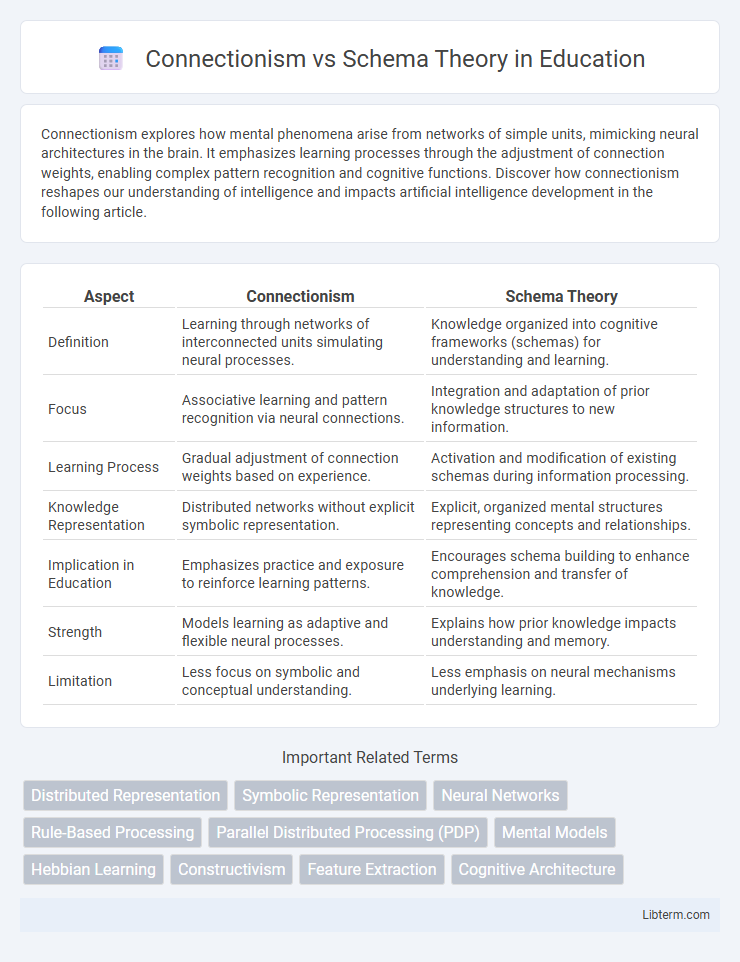Connectionism explores how mental phenomena arise from networks of simple units, mimicking neural architectures in the brain. It emphasizes learning processes through the adjustment of connection weights, enabling complex pattern recognition and cognitive functions. Discover how connectionism reshapes our understanding of intelligence and impacts artificial intelligence development in the following article.
Table of Comparison
| Aspect | Connectionism | Schema Theory |
|---|---|---|
| Definition | Learning through networks of interconnected units simulating neural processes. | Knowledge organized into cognitive frameworks (schemas) for understanding and learning. |
| Focus | Associative learning and pattern recognition via neural connections. | Integration and adaptation of prior knowledge structures to new information. |
| Learning Process | Gradual adjustment of connection weights based on experience. | Activation and modification of existing schemas during information processing. |
| Knowledge Representation | Distributed networks without explicit symbolic representation. | Explicit, organized mental structures representing concepts and relationships. |
| Implication in Education | Emphasizes practice and exposure to reinforce learning patterns. | Encourages schema building to enhance comprehension and transfer of knowledge. |
| Strength | Models learning as adaptive and flexible neural processes. | Explains how prior knowledge impacts understanding and memory. |
| Limitation | Less focus on symbolic and conceptual understanding. | Less emphasis on neural mechanisms underlying learning. |
Introduction to Connectionism and Schema Theory
Connectionism models cognitive processes through interconnected networks of simple units simulating neural structures, emphasizing learning via pattern recognition and parallel distributed processing. Schema Theory explains knowledge organization as mental frameworks or schemas that guide perception, understanding, and memory based on existing structures. Both frameworks offer distinct perspectives on cognition: Connectionism highlights dynamic learning mechanisms, while Schema Theory focuses on structured knowledge representation.
Historical Development of Both Theories
Connectionism emerged in the 1940s with early models like the perceptron, reflecting the brain's neural networks through interconnected nodes that simulate learning processes. Schema Theory developed in the 1970s, rooted in cognitive psychology, emphasizing how mental frameworks or schemas organize knowledge and influence information processing. Both theories evolved through advances in artificial intelligence and cognitive science, with Connectionism focusing on parallel distributed processing and Schema Theory on structured knowledge representation.
Core Principles of Connectionism
Connectionism rests on the core principle that cognitive processes emerge from networks of simple, interconnected units called neurons, which process information simultaneously through weighted connections. Learning occurs by adjusting these connection weights based on experience, enabling pattern recognition and parallel distributed processing. This approach contrasts with Schema Theory's emphasis on stored mental frameworks, as Connectionism models cognition as dynamic, adaptive, and rooted in neural network activity.
Fundamental Concepts in Schema Theory
Schema Theory centers on cognitive structures called schemas, which are mental frameworks that organize knowledge and guide information processing. These schemas help individuals interpret new experiences by fitting them into existing cognitive patterns, facilitating understanding and memory. Unlike Connectionism, which emphasizes neural network models and learning through weighted connections, Schema Theory highlights the role of preexisting mental constructs in shaping cognition.
Mechanisms of Learning and Memory
Connectionism models learning and memory through networks of interconnected nodes, emphasizing parallel distributed processing and the gradual strengthening of synaptic weights based on experience. Schema Theory posits that learning involves the formation and adaptation of mental frameworks or schemas, which organize knowledge and guide information processing through assimilation and accommodation. While Connectionism relies on neural-like connectivity patterns for pattern recognition and generalization, Schema Theory centers on structured knowledge representations that influence memory retrieval and comprehension.
Representation of Knowledge
Connectionism represents knowledge through distributed networks of simple units, where information is encoded in patterns of activation across nodes. Schema Theory organizes knowledge into structured frameworks or mental templates that guide perception and understanding by categorizing experiences. Unlike the flexible, parallel processing of Connectionism, Schema Theory emphasizes hierarchical, symbolic structures for knowledge representation.
Strengths and Limitations of Connectionism
Connectionism excels at modeling cognitive processes through artificial neural networks that simulate learning and pattern recognition, enabling robust handling of parallel distributed processing and adaptive learning from experience. Its strengths lie in capturing gradual learning, generalization, and fault tolerance, making it effective for tasks like language acquisition and visual recognition. Limitations include difficulties in representing abstract knowledge explicitly, challenges with symbolic reasoning, and limited capacity for explaining rule-based or hierarchical cognitive structures.
Advantages and Critiques of Schema Theory
Schema Theory offers advantages such as facilitating efficient information processing by organizing knowledge into structured frameworks, which enhances comprehension and memory recall. It explains how prior knowledge influences new learning and supports prediction and inference during cognitive tasks. Critiques of Schema Theory highlight its potential oversimplification of cognitive processes, the difficulty in empirically testing schemas, and challenges in accounting for the flexibility and dynamic nature of knowledge acquisition.
Real-world Applications and Impacts
Connectionism models cognitive processes through neural networks, facilitating advancements in artificial intelligence, such as speech recognition and adaptive learning systems. Schema Theory influences educational strategies by emphasizing structured knowledge frameworks, improving reading comprehension and problem-solving skills in real-world classrooms. Both theories enhance human-computer interaction design by informing adaptive interfaces that mimic human learning and memory patterns.
Future Directions in Cognitive Modeling
Future directions in cognitive modeling emphasize integrating connectionism's neural network frameworks with schema theory's structured knowledge representations to enhance adaptive learning systems. Emerging research explores hybrid models that leverage connectionist pattern recognition with schema-based rule application for more robust, context-sensitive cognitive simulations. Advances in deep learning and symbolic AI offer promising avenues to simulate dynamic human cognition by combining distributed processing with hierarchical schema organization.
Connectionism Infographic

 libterm.com
libterm.com